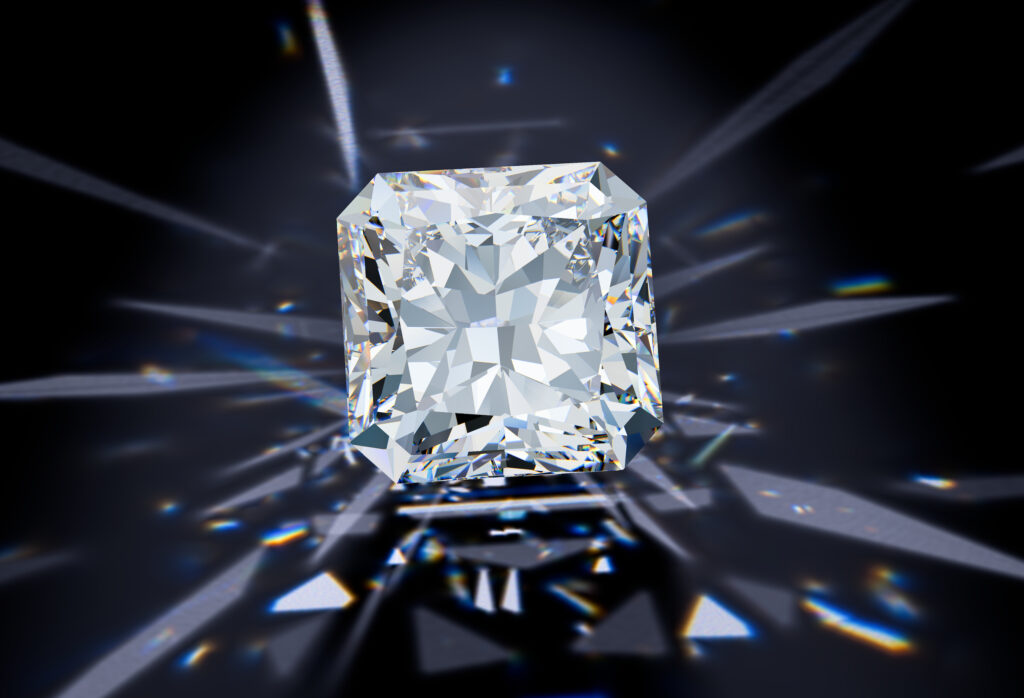Moissanite is a fantastic alternative to diamond, boasting almost every attribute of the legendary gemstone, but does it sparkle?
Moissanite has a rather unique sparkle that can give off ‘rainbow’ flashes if it catches the light just right. While the sparkle of a diamond is almost unbeatable, a moissanite stone has a similar refractive index that ensures it too can sparkle and reflect light in an attractive way.

Read on to learn more about moissanite, where it comes from, and how it differs from diamonds.
Make A Little More Moissanite
While diamonds are considered the undisputed champion of the jewelry world, there are some alternatives that come quite close to beating them. For example, there are the colored stones that are commonplace throughout the industry: rubies, sapphires, and emeralds.
However, it doesn’t stop there, and there are many other stones that are so similar to diamonds that only an expert will be able to tell the difference. At the bottom of the spectrum sits the lab-made but rather weak cubic zirconia, a common alternative to diamonds.
In a similar place on the scale sits glass, which can be cut in similar ways to a diamond, but lacks any kind of durability. It’s by far the least popular option for a diamond alternative, as it can break and scratch with ease.
There are also several stones that have a white coloration that can pass for a diamond, such as a colorless sapphire or a white topaz. Finally, there’s quartz, which is arguably the most common gemstone mineral on Earth – it’s cheap and easy to cut, but lacks brilliance.
Although, there is another stone that acts as a viable alternative to diamond, it is considered to be in a league of its own. This gemstone is called moissanite, a unique and durable gemstone that matches diamonds in almost every aspect.
Firstly, moissanite has a similar refractive index, meaning it sparkles in a similar way to a diamond – not the same way, though. Moissanite boasts a unique sparkle that can produce flashes of rainbow coloration if the light catches it just right.
Furthermore, moissanite is almost as tough as a diamond, which is the hardest material known to man. However, the main benefit of a moissanite stone is that, while it is remarkably similar to a diamond, it comes with a much lower price point on average.
Ultimately, every moissanite stone today is lab-grown, meaning it’s an eco-friendly alternative to diamonds that will always be readily available. When you’re looking for an attractive alternative to a diamond, you should look no further than moissanite.
The Stone Sent From The Stars
As the story goes, moissanite was discovered by a chemist named Henri Moissan, way back in 1893. He’d found traces of moissanite hidden deep within a meteor crater in Arizona, and at first, he thought he’d found evidence of diamonds existing there.
However, after he’d examined the elements he’d uncovered, he realized he was holding an entirely new gemstone. This discovery took around ten years, and Moissan didn’t identify the material as moissanite (as it would come to be known) until 1904.
As the years wore on, more moissanite stones were extracted from meteorites, and it wasn’t until the 1950s that moissanite was allegedly found on Earth. These claims have long been disputed, and today, there is almost no evidence that moissanite naturally occurs anywhere other than meteorites.
Like many other gemstones in the world, moissanite can be manufactured in a laboratory environment in a matter of days. There’s almost no difference at all between a lab-grown moissanite stone and a natural moissanite stone – not that they really exist, though.
It’s the same as a diamond – you can either mine a diamond from the Earth or grow it in a lab. The end result is pretty much identical, and you’ll still be left with a beautiful diamond that sparkles and bears the durability traits that the stone is famed for.
If you’re purchasing a lab-grown moissanite stone, you can rest assured that it will still exhibit that rainbow-flash sparkle that it’s known for. Furthermore, you’ll be happy to know that you’re saving a lot of money and likely getting a bigger gemstone for your buck.
There are plenty of retailers in the United States that sell moissanite stones and jewelry, and they’re just a click away. If you’re interested in checking out some of these examples, take a look at an article that we wrote explaining where in the U.S. you can buy moissanite.
